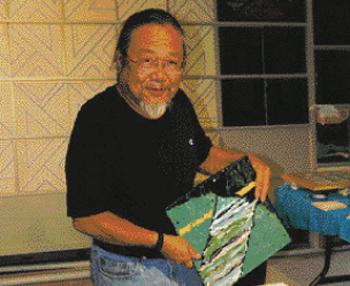HA‘ENA — If you think retirement is a time to slow down, take up golf and work in the yard, think again. Though Lihu‘e native and world-renowned ceramicist David Kuraoka officially retired from his full-time gig as instructor and head of
HA‘ENA — If you think retirement is a time to slow down, take up golf and work in the yard, think again.
Though Lihu‘e native and world-renowned ceramicist David Kuraoka officially retired from his full-time gig as instructor and head of the Ceramics Department at San Francisco State University, don’t expect him to lounge on one of the world-class beaches near his home — for long, anyway.
After “retirement,” he accepted his school’s offer to teach fall semester only, which gives him the rest of the year to continue creating various forms of ceramics in San Francisco, Ha‘ena and Wainiha.
He needs to have a lot of time on his hands, since his kiln-fired pieces take a week of kiln time before they’re ready, and his pitfired pieces take even longer, with the heating up, maintenance of heat and cooling-off periods all crucial to optimum creation, he said in his Ha‘ena studio earlier this week.
Also, his latest love, square tiles each 13 by 13 inches, take around six weeks for a dozen. The pieces are shipped from San Francisco (at an attrition rate of way over 50 percent due to breakage during shipping, though he’s thankful 350 of the 800 did make it in one piece), and Kuraoka decorates them with chemical or formulated glass dispensed onto the tiles with large, mustard squeeze bottles.
It goes on liquid, dries, then is fired.
He chose squares, he said, “because it’s difficult to do. So I sought out to solve the square.”
Not that the pitfired glazed, geometric forms were new to him. He delved in vertical rectangles, that were hanging next to fireplaces, and when he was preparing to move back to Kaua‘i for good (sort of), he dug up the rectangular pieces.
“I kind of found them by accident,” he said of the rectangles.
Other things going on in his “retirement” include a two-person show, “Crosscurrents,” completed at the end of April with fellow ceramicist Jun Kaneko, at the Schaefer International Gallery of the Maui Arts & Cultural Center.
Some 19 crates of his work recently arrived back on Kaua‘i from the Maui show, minus an untitled glazed form that was recently purchased for the State Foundation on Culture and the Arts permanent collection.
Next month, he and wife Carol Kuraoka will be off to O‘ahu for the Hawai‘i Craftsmen Raku ‘09 Ho‘olaule‘a, with David Kuraoka an invited artist.
He will offer a free slide lecture June 2 at the University of Hawai‘i-Manoa Art Auditorium, and the beachside firing and camping event is June 4-8 at Waimanalo Bay Beach Park.
Also, he and San Francisco State University created “Firing A Legacy,” subtitled “David Kuraoka & San Francisco State University,” gathering together at one time in one location some of the many instructors and ceramicists Kuraoka has taught and influenced over his 38 years at the university.
The show photographer and show installer were both former students, he said, and the show was exceptional.
It was a cultural phenomenon, and the fact that the instructors and ceramicists he taught over three generations did not generally know each other surprised him. He thought that, since he knew them all, that they all knew each other.
Among them is former Kauaian Margaret Haydon, now an associate professor at the University of Wyoming at Laramie. She received her bachelor’s degree from Oberlin College in Ohio, and her master’s at San Francisco State University.
Kuraoka, 62, is not even considering putting his creativity into retirement. “I’m about growing,” he said.
For example, he got a surprised look and surprised comment when he asked a contemporary to teach him how to make bowls, because some of his bowls are award-winners and prized in private collections.
“I enjoy throwing,” and while some make fun of bowl-makers, “I want to know how to make bowls. I’m not good at everything.”
That is sort of the way he feels about his square tiles. “I took the challenge of putting life into something small. My new series came out very well.”
Showing his sketchbook, his creation process, as it were, starting with regular black pencil and eventually adding color, he explains the thought processes going into his newest creations.
In 1999, he began converting some of his ceramic pieces to bronzes, to acclaim from fellow artisans and gallery owners and some commercial success as well.
Secretary of State Hillary Rodham Clinton, Kaua‘i Museum, Rotterdam Modern Museum of Art and Utah State University all have Kuraoka pieces in their collections.
Originally from Lihu‘e, the son of Emiko Kuraoka of Puhi and the late Matsuo “Sidelines” Kuraoka, David Kuraoka maintains homes and studios in Wainiha, Ha‘ena and San Francisco.
His father was a longtime sports writer, photographer and columnist with The Garden Island newspaper.
David Kuraoka moved to the Bay Area in 1964 to attend San Jose City College, and finished with bachelor’s and master’s degrees in art from San Jose State University. He was awarded the equivalent of a doctorate by San Francisco State University in 1976.
With San Francisco State University for 38 years, he was named head of the Ceramics Department in 1982.
He was named a Hawai‘i Living Treasure in 1987 at age 41, the youngest person ever to receive the honor.
One of his signature pieces, Na Pali, is on the wall of the Lihu‘e Airport Richard A. Kawakami Terminal, near the restaurant and bar, a 10-foot-by-50-foot mural commissioned by the SFCA.
• Paul C. Curtis, staff writer, can be reached at 245-3681 (ext. 224) or pcurtis@kauaipubco.com



